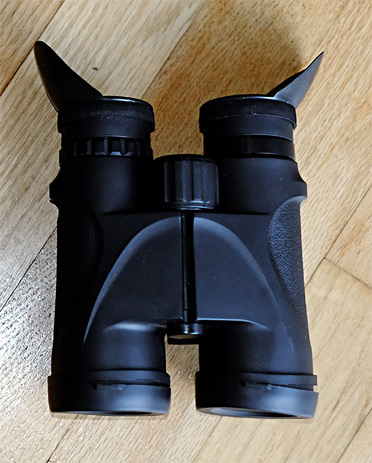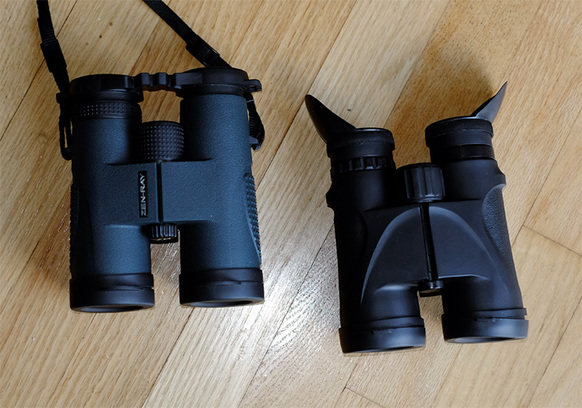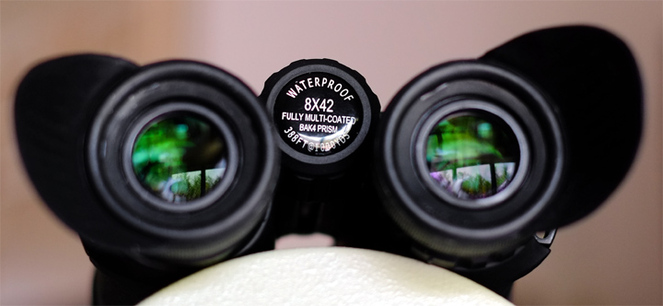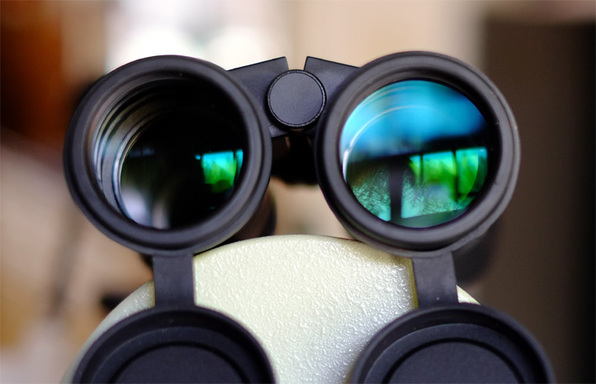First Light with the Prototype 8×42 Space WalkerTM 3D Binoculars
By: William A. Paolini
The Space Walker 3D Binoculars are a continuation of the 3D technology innovated by Russ Lederman of 3D Astronomy (www.3dastronomy.com). Like the 3D technology used in the L-O-A 21 eyepieces for telescope binoviewers, the Space Walker 3D binoculars use the same L-O-ATM (Lederman Optical Array) technology, only this time applied to the eyepieces of the binocular. The Space Walker’s are 8×42 roof prism binoculars that feature phase corrected FMC coatings, BAK-4 roof prisms, dielectric prism coatings, 60° apparent field of view (AFOV) eyepieces, diopter adjustment, center focusing, rubberized armoring, waterproofing, foldable batwing eye guards, twist up eyecups, caps for the objectives and eyepieces, and an unpadded carry case with strap.

Overall the Space Walker’s have the look and feel of a quality binocular. Comparing them to my Zen-Ray ZRS HS 8×42 Summit binoculars, the Space Walkers had a similar heft and sturdy feel about them. Optically they pulled in dimmest stars equally as well my Zen-Ray’s, but produced a true field of view (TFOV) just slightly smaller. Edge correction appeared typical for a binocular of this price class, and stars were pleasingly sharp over the majority of the field of view with no readily apparent chromatic aberrations (CA) during any of my field usage. I was not used to having winged eye guards on a binocular before, but found I liked using them as they did eliminate stray light from the environment by blocking peripheral vision. The winged eye guards on the prototype can only be used however with the adjustable eye cups in the fully down position, but will be rotate-able on the production units.

For my first light experiment, I decided to spend several outings using just the binoculars, so not using a telescope. This way I could concentrate more on just binocular observing. I typically use binoculars as an aid with the telescope in hunting down targets, or to observe very large targets where the telescope is not so appropriate. I would therefore not call myself a binocular astronomer, but more of a casual observer with binoculars. When I do use either my Zen-Ray 8×42’s or my Nikon 12×50 AE’s for astronomical observing, I typically find them enjoyable and like the transition of observing low power with the 8×42’s then using the 12×50’s in order to zero in on more details when a target catches my interest. So I was curious how I would react to the Space Walker’s given that I do not do binocular astronomy often and that I prefer the dual binocular approach.
Over several evenings of use I observed a variety of my favorite targets, and also did some general scanning and exploring. Targets I visited included Orion’s Belt, Orion’s Sword with M42, Rigel, Betelgeuse, M31, the Double Cluster, M45 Pleiades, M36, M37, M38, Hyades (Collinder 50), several rich star fields, several double stars, and the Moon. During these forays into the night skies I had all three binoculars at the ready because I wanted to see if I developed a preference on any one over the other.

My initial observation was of Orion’s belt, and then the Sword. In both cases the targets easily fit within the FOV. Orion’s sword was simply stunning to observe. The myriad of stars in and around the Belt made for a mesmerizing 3D experience. Frankly, I could have stayed there all evening it was so intriguing. The 3D effect was pronounced, so nothing subtle about it at all. There were 3 array elements in the binoculars, one dead center, then high left and lower right. Including the non-arrayed area this means 4 levels of depth are presented in the view. I really enjoyed how the central array, being positioned in the exact center of the FOV and showing those targets nearest, served to focus attention on the central target. So having the center area show like it is nearest, made it stand out for me as an attention getter and focus of the observation. Turning to the Sword of Orion, again a similar reaction as the area is rich with the M42 nebula showing brightly and distinctly. With M42, I found it enjoyable to move it to different positions and depths in the FOV as this provided multiple interesting perspectives to the observation where the nebula had either most prominent or lesser prominent attention.
As I further scanned around the evening sky, I did not find any target where the 3D aspect of the view could not be easily seen. Even on sparse FOVs where there was just a single prominent bright star in view, when I placed it in the center the bright star still appeared noticeably nearer than the background sky. So this lead me to observe more of the brightest stars as primary targets as even when in sparse fields with little else around them it remained enjoyable and interesting to observe because of the perception of depth. While I was doing this bright star activity, I eventually turned to Rigel which was low on the horizon during my observations of this target. Given the large TFOV of most binoculars compared to telescopes (approximately 7.4° TFOV for the Space Walkers), this meant for me that a part of a tree in my yard would also be framed. When Rigel and the tree were both in the FOV a most amazing thing happened. Since the tree was close at less than 50 feet away, I was seeing it in natural parallax 3D — so it appeared closer in 3D naturally without the need for the LOA arrays given how close it was to me while using my binocular vision with the binoculars. Rigel, while appearing closer than the background sky from the arrays, it seemed to be only a little further away. As a result, it appeared to be hanging in the distance between my tree and the sky! This was such an intriguing perspective that I began to move around placing more of the tree in the FOV, and even placing the leafless tree between me and Rigel to accentuate the perspective even more. Incredibly fun, and of course this made me start including trees in my FOV whenever I could!
After all the fun looking at near horizon targets where I could place trees in the FOV, I again turned upward to celestial targets only. Basically, everything I observed was nicely portrayed with varying depths. When I began the observations, I switched often between my standard 8x42s (Zen-Ray ZHD Summits) and the Space Walker 8x42s to compare views. However, as time wore on I abandoned the standard binoculars as their view was very much less engaging than the Space Walkers and their optical performance (sharpness, contrast, brightness) was visually no better. This surprised me really as I love my Zen-Rays. And while looking at targets high in the sky, I was met with yet another surprise akin to that of the trees when I was observing near the horizon. In this instance I was observing the rich field around the star Hamal in Aries. While doing this, as often happens, a high flying passenger aircraft crossed the FOV. To my amazement, when it did this it appeared as it was flying at a location further away than some of the closer stars in the FOV, but closer than the furthest away looking stars. In effect, it made the aircraft appear more like a spacecraft going along its journey through space amidst the stars instead of some terrestrial craft coursing just overhead! Upon seeing this, I of course started looking for the airliners to observe as this made the night sky seem alive with futuristic space faring peoples crisscrossing the universe as I watched from below.
My observations during these first light tests over the course of a couple of weeks were limited to my home location, which means they were conducted in a suburban area that moves between a white to bright red zone (i.e., light polluted). I wanted to try the Space Walkers at a dark site, but only had them for a few weeks and my few weekends with them were unfortunately rained out. I can only imagine how intriguing they might have been at a dark site and look forward to getting a production unit for that experience. As far as any unusual artifacts from the arrays, they only showed the edge of the arrays for me when I viewed close to the horizon where the sky was very bright, and when this did happen only one array showed an edge. The double star artifact mentioned in my review of the L-O-A 21 eyepieces, where a star may appear to split when it crosses an array boundary, also happened for brighter stars with the Space Walkers as well, but like the L-O-A 21’s I did not find it overly distracting in most instances as it was typically transient in nature. As a reminder, my test units were prototypes and am told that the production units will have an improved array that should mitigate both artifacts significantly.
Overall, the various clusters and stars I observed, including nebula (M42) and galaxies (M31), all showed brightly with pleasing contrast in the Space Walkers. I saw no obvious difference in optical attributes between the views of the Space Walkers vs. those of my very good quality Zen-Rays, excepting that the TFOV of the Space Walkers was just a little smaller than the Zen-Rays (388 ft @ 1000 yards or 7.4° vs. 393 ft @ 1000 yards or 7.5°). So I felt that Space Walkers with 3D technology were just as effective for me when used for target acquisition in aiding my telescope observing, and they were more effective for me when conducting dedicated binocular astronomy since their 3D view brought engaging depth perspectives to the view.

Final Thoughts
The Space Walker 3D Binoculars were a complete joy to use and as effortless as any binocular. There was no adjusting needed for the 3D effects as it is built into the product with no adjustment capability for the user. As a result, these 3D binoculars were intuitive and effortless, providing bright, sharp, and nicely contrasted astronomical views with very pronounced levels of depth. I found them just as useful and precise as a standard binocular when used to help find targets for observing with the telescope, and I found them much better than conventional binoculars when used for dedicated binocular astronomy. And while the very real parallax 3D effects of the Space Walkers are not showing the actual depth positions of the various objects in the FOV, I found this did not hinder the appreciation or precision of the observation, but instead accentuated it as it aided in the focusing of attention and reminded me that what I am observing is a universe in 3 dimensions instead of a flat 2 dimensional space. I am very much looking forward to the final production version of this product as it brought a level of enjoyment and intrigue to binocular observing for astronomy that I had not experienced before!
